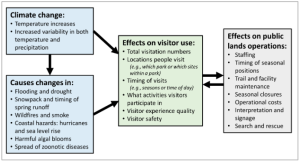A Review of the Effects of Climate Change on Visitor Use in US Public Lands and Waters
Citation
Wilkins, E. J., Rappaport, S. L., Carr, W., Reas, J., Winder, S. G., & Wood, S. A. (2025). A review of the effects of climate change on visitor use in US public lands and waters. Science Report, (NPS/SR—2025/231). doi.org/10.36967/2306946
Climate change is already affecting how people visit U.S. public lands and waters — shaping when they go, what they do, and their overall safety. This report reviews existing research on these impacts and explores how visitor use may change in the future.
This report aims to give land and water managers, especially within the National Park Service, a clear overview of current knowledge and a foundation for developing a climate change vulnerability assessment for visitor use, one that could also apply to other federal lands and waters.
- The authors focus on seven key climate-related factors:
- Rising temperatures
- Flooding, drought, and more variable precipitation
- Declining snowpack and earlier spring runoff
- Wildfires, smoke, and air quality
- Coastal threats like hurricanes and sea level rise
- Harmful algal blooms (HABs)
- Zoonotic and vector-borne diseases
Research shows these factors are already impacting visitation and are likely to worsen as climate change intensifies. The report also summarizes how visitors are adapting and highlights areas where more research is needed to help managers plan and respond effectively.
Abstract

Climate change is affecting recreational visitor use in U.S. public lands and waters, causing changes to visitation levels, timing of trips, activity participation, and visitor safety. This report reviews the literature on how climate change is influencing visitor use in the United States and how visitor use may be affected in the future. Our goal is to provide the current state of the literature for managers of public lands and waters and provide foundational information for the development of a climate change vulnerability assessment methodology for visitor use within the National Park Service (that may be applicable to other federal lands and waters). Specifically, we investigate how seven different climate change factors may affect visitor use on public lands and waters. These factors consist of increasing temperatures; flooding, drought, and increased variability of precipitation; decreasing snowpack and earlier spring runoff; wildfires, smoke, and air quality; coastal hazards: hurricanes and sea level rise; harmful algal blooms (HABs); and zoonotic and vector-borne disease. The current research indicates that these factors are already affecting visitors to public lands and waters and continued effects in the future are likely as the climate warms. Additionally, we summarize existing research on how visitors to U.S. public lands and waters are adapting to climate change. Throughout the review, we note where there are substantial gaps in the literature and more research would help managers respond to the effects of climate change on visitor use.